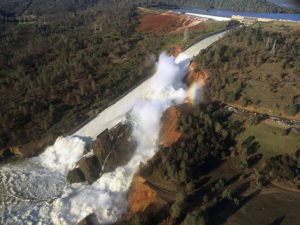
Aerial photo released by the California Department of Water Resources, showing the damaged spillway with eroded hillside in Oroville
The spillway recently made news when it began ripping away under unusually heavy rain and snowmelt. Some 188,000 people had only hours to escape.
This sort of engineering mistake is similar to what happened in the 1980s when the US Army Corps of Engineers was behind schedule in building protective hurricane levees in New Orleans.
Faced with ever-increasing costs, the Corps of Engineers Mississippi Valley Division headquarters in Vicksburg initiated a large-scale Sheet Pile Test (the E-99 Study) in the Atchafalaya Basin, a region with soft clayey and organic soils, similar to those in New Orleans. In 1985, the Corps misinterpreted the results of the E-99 Study.
The Corps wrongly determined that it needed to drive sheet piles down to depths of only 17 feet instead of between 31 and 46 feet. This shortcoming allowed the floodwalls of the 17th Street and London Avenue Canals to fail several feet below what they were designed to hold.
Like the Oroville Dam spillway, decisions made when in a rush resulted in disaster.
The cause for the rush in building the tallest dam in American has been pinned on the late Governor Pat Brown who wanted the project to be his personal legacy.





Leave a Reply